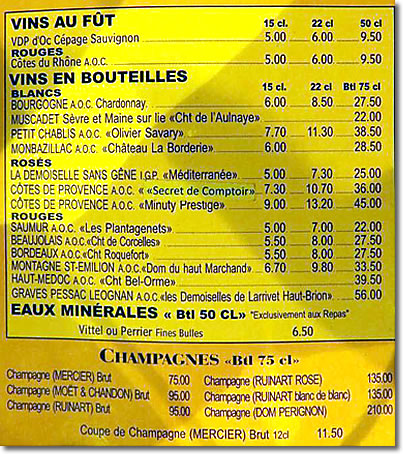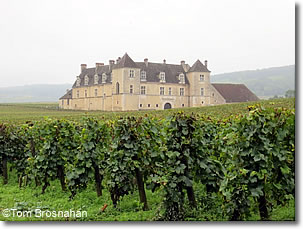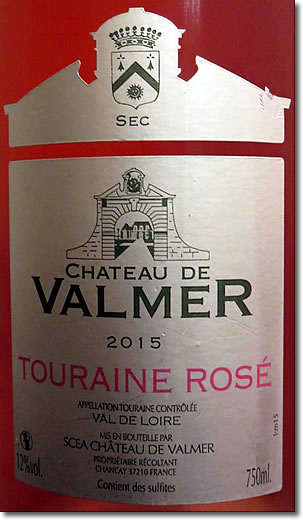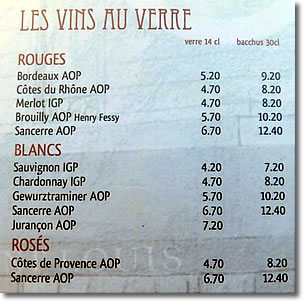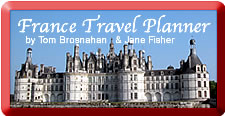 |
French Wine Guide | |
| French wines are labeled not by type of grape but by region and vineyard. There are nearly 500 of those—so how do you know what to order? Here's some help. | ||
|
|
|
Wine has been made in France for at least 2,600 years, and France is famed as one of the world's largest and best producers of wine. Enjoying wine is one of the great pleasures of travel in France, but ordering it in a restaurant can be confusing. Here are some tips to make ordering wine simpler. First rule: order whatever you like! Yes, most French wines are made for dining (rather than for bar-sipping), and certain types of wine match well with certain types of dishes. But there are no hard-and-fast rules, and it's your dinner, so order whatever you think you'll enjoy. Order by price if you like. If you'd like suggestions, ask your waiter, who should know. Red? White? Rosé?France is a large country, nearly 1200 km (746 miles) from Calais in the northwest to Perpignan in the southeast. White wines are best grown in the cooler climate of the north—think Champagne, the Loire Valley, and the Rieslings, Muscats and Gewürztraminers of Alsace. Red wines prefer the warmer temperatures and abundant sunshine of southern France: Bordeaux, Côtes-du-Rhône, and Languedoc vintages such as Corbières. Rosé wines, made from red or black grapes, are a specialty of Provence in the southeast. Burgundy (Burgogne), perhaps the premier French wine-growing region, in east-central France, produces red, white and rosé wines, though mostly reds. Those Wine Bottle Labels...Go wine shopping in the USA, Australia and many other winemaking countries, and you'll often see the name of the grape from which the wine is made displayed prominently on the label: Chardonnay, Cabernet Sauvignon, Merlot, Sauvignon Blanc. You'll also see the wine company name and perhaps the vineyard region: Sunnyhill Vineyards Chardonnay, North Coast. In France, the most prominent names on the label are those of the region and the vineyard. French wine-drinkers know that each region has its traditional wine grape varieties—Cabernet Sauvignon in Bordeaux, Chardonnay in Champagne and Burgundy, Sauvignon Blanc in the Loire Valley, Riesling in Alsace, so to French wine-lovers, the name of the region usually indicates the grape. (There's more about French wine-growing regions below.) Here's a simple café-bar-restaurant wine list:
QualityAll French wine is subject to strict controls, with the quality classification and location of origin printed on the label. In 2012 the old classification system of Vin de Table, Vin de Pays, Vin délimité de qualité supérieure, and Appellation d'origine contrôlée (AOC) was changed to this: Vin de FranceThe broadest classification, like Vin de Table. The vineyard, winery and grape variety may be anything, from anywhere in France. Grape variety and vintage may be included on the label, but are not required. These are usually simple, inexpensive wines, vin ordinaire. IGP: Indication géographique protégéeGuaranteed to be from a particular region of France, such as Alsace, Bordeaux, Burgundy, Loire, etc., IGP wines may be from any vineyard(s), vintage, year, or wineries in that region. These wines may have more of the quality and characteristics of the region in which they are made than do Vins de France. AOP: Appellation d'origine protégéeAOP wines are the highest category, replacing AOC. Labels for wines in this category indicate the exact location and vineyard, and bear the words Appellation [location] Protégée. In restaurants, if you see the abbreviation AOP after the name of a wine, it means that it is of the highest classification. These wines may have further clasifications, such as the particular vineyard, château, town, or vintage (year). In general, the more specific the classifications, the better and more expensive the wine. Wine RegionsPerhaps because of France's popularity with foreign visitors, some restaurants in tourist areas now mention grape varieties in their wine lists to make selection easier for wine lovers who know the grapes, but not the French regions. Even so, the better IGP and AOP wines always tell you their region, so knowing France's most prominent winemaking regions will help you order. AlsaceMostly white wines, fruity and sweeter, from Gewurtztraminer, Muscat, Pinot blanc, Pinot gris, and Riesling grapes. BordeauxMostly red wines from Cabernet Franc, Cabernet Sauvignon, Malbec and Merlot grapes, including some of the finest wines in the world (from Margaux, Médoc, Pomerol, Saint-Émilion, etc.), but also exquisite sweet white dessert wines from the Semillon grape, such as Château d'Yquem. BurgundyThe most famous French wine region produces fine red (Pinot noir) and white (Chardonnay, Aligoté) wines from sub-regions Beaujolais, Chablis, Côte Chalonnaise, Côte de Beaune, Côte de Nuits, Côte d'Or, Mâcon, usually at higher prices. Crémant de Bourgogne sparkling wines now compete with champagnes. ChampagneThe most famous white and rosé sparkling wines in the world are made from Chardonnay, Pinot noir and Pino Meunier grapes. Other wine regions in France are in full competition with Champagne. They can't call their sparkling wines champagne, so they call them crémant, which means "champagne-type wine that's not from Champagne." Languedoc-RoussillonFrance's largest wine region produces lots of inexpensive Vin de France and IGP wines from Cinsault, Grenache noir, and other varieties, often marketed as Vin de Pays d'Oc. LoireLoire wines are mostly white from Cabernet franc, Chenin blanc, Gamay, Melon de Bourgogne and Sauvignon blanc grapes, including such locations as Anjou, Chinon, Sancerre, Saumur, Touraine and Vouvray. ProvenceThe warm, sunny south is best for red and rosé wines from Cabernet Sauvignon, Cinsault and Syrah (Shiraz) grapes, such as Côtes de Provence, Côtes d'Aix-en-Provence, and Bandol, with rosé wines providing more than half of all production. When you want rosé, try a Provence wine. RhôneRhône Valley wines are mostly red, similar to those of Bordeaux, produced as Côtes-du-Rhône. Northern Rhône wines are often reds from the Cinsault and Syrah (Shiraz) grapes, and white wines from Marsanne, Roussane and Viognier. Southern Rhône's most famous red is the noble, powerful Châteauneuf-du-Pape, a blend of grapes, but the south produces whites and rosés as well. Other RegionsWine is produced everywhere in France, but in the less renowned winemaking regions the production is mostly consumed locally. This gives you the chance to taste the local soil and sun in such regions as Brittany, Corsica, Île-de-France, Jura, Normandy, and Savoie (Savoy). The Simplest WayIf you just want a simple glass of wine to sip or to accompany your meal, ask for un verre de vin of the color you prefer: blanc (white), rouge (red), rosé, or mousseux ("mew-SOO," sparkling). You will probably be served a glass of Vin de France at a low price. A glass is usually 12cl to 14cl (4 to 5 US fluid ounces). For more, ask for un pichet (a pitcher, carafe). Usual sizes are 25cl (2 glasses), 46cl or 50cl (2/3 bottle) or 1 liter (1.33 bottle), but you may find other designations, such as 22cl (a larger glass), or an even larger bacchus (30cl).
|
|
Clos de Vougeot, Nuits-Saint-Georges, Burgundy.
This label provides the following classifications:
|



